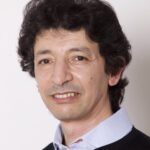Link to Pubmed [PMID] – 8842737
Link to HAL – pasteur-04036407
Link to DOI – 10.1093/hmg/5.8.1171
Human Molecular Genetics, 1996, 5 (8), pp.1171-1178. ⟨10.1093/hmg/5.8.1171⟩
Usher syndrome type I (USH1) associates severe congenital deafness, vestibular dysfunction and progressive retinitis pigmentosa leading to blindness. The gene encoding myosin VIIA is responsible for USH1B. Mutations in the murine orthologous gene lead to the shaker-1 phenotype, which manifests cochlear and vestibular dysfunction, without any retinal defect. To address this phenotypic discrepancy, the expression of myosin VIIA in retinal cells was analyzed in human and mouse during embryonic development and adult life. In the human embryo, myosin VIIA was present first in the pigment epithelium cells, and later in these cells as well as in the photoreceptor cells. In the adult human retina, myosin VIIA was present in both cell types. In contrast, in mouse, only pigment epithelium cells expressed the protein throughout development and adult life. Myosin VIIA was also found to be absent in the photoreceptor cells of other rodents (rat and guinea-pig), whereas these cells expressed the protein in amphibians, avians and primates. These observations suggest that retinitis pigmentosa of USH1B results from a primary rod and cone defect. The USH1B/ shaker-1 paradigm illustrates a species-specific cell pattern of gene expression as a possible cause for the discrepancy between phenotypes involving defective orthologous genes in man and mouse. Interestingly, in the photoreceptor cells, myosin VIIA is mainly localized in the inner and base of outer segments as well as in the synaptic ending region where it is co-localized with the synaptic vesicles. Therefore, we suggest that myosin VIIA might play a role in the trafficking of ribbon-synaptic vesicle complexes and the renewal processes of the outer photoreceptor disks

